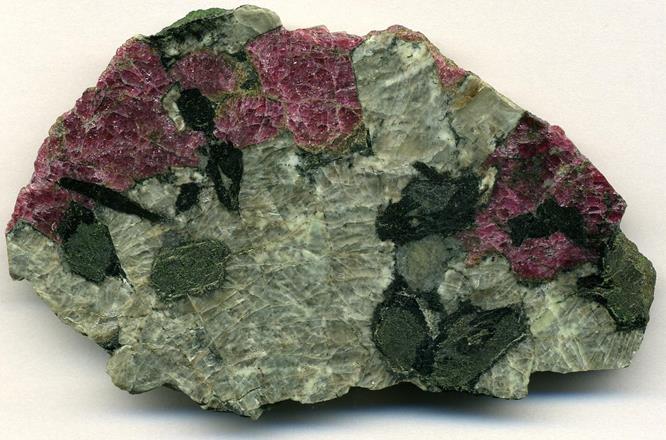Granitic pegmatite
A pegmatite is a holocrystalline intrusive igneous rock composed of interlocking phaneritic crystals usually larger than 2.5cm in size. The word pegmatite derives from Homeric Greek (pegnymi), which means to bind together, in reference to the intertwined crystals of quartz and feldspar in the texture known as graphic granite. Pegmatites are extreme igneous rocks that form during the final stage of a magma's crystallization. They are extreme because they contain exceptionally large crystals and they sometimes contain minerals that are rarely found in other types of rocks. Most pegmatites have a composition that is similar to granite (granite pegmatites) with abundant quartz, feldspar, and mica. However, compositions such as gabbro pegmatite, syenite pegmatite, and any other plutonic rock name combined with pegmatite are possible. Pegmatites are sometimes sources of valuable minerals such as spodumene (rich in Li) and beryl (rich in Be) that are rarely found in economic amounts in other types of rocks. They also can be a source of gemstones.Large crystals in igneous rocks are usually attributed to a slow rate of crystallization. However, with pegmatites, large crystals are attributed to low-viscosity fluids that allow ions to be very mobile. During the early states of a magma's crystallization, the melt usually contains a significant amount of dissolved water and other volatiles such as chlorine, fluorine, and carbon dioxide. Water is not removed from the melt during the early crystallization process, so its concentration in the melt grows as crystallization progresses. Eventually there is an overabundance of water, and pockets of water separate from the melt. These pockets of superheated water are extremely rich in dissolved ions. The ions in the water are much more mobile than ions in the melt. This allows them to move about freely and form crystals rapidly. This is why crystals of a pegmatite grow so large.
The extreme conditions of crystallization sometimes produce crystals that are several meters in length and weigh over one ton. For example: a large crystal of spodumene at the Etta Mine in South Dakota was 42 feet long, 5 feet in diameter and yielded 90 tons of spodumene.
Pegmatites form from waters that separate from a magma in the late stages of crystallization; this activity often occurs in small pockets along the margins of a batholith. Pegmatite can also form in fractures that develop on the margins of the batholith. This is how pegmatite dikes are formed.
Large intrusions of feldspathoid syenites are commonly accompanied by pegmatites, veins, lenses and pods of coarse-crystalline material comprising the same minerals as found in the surrounding rocks (nepheline, sodalite, alkali feldspars, aegirine and sodic amphiboles), as well as copious quantities of rare minerals enriched in water and incompatible trace elements: Sr (lamprophyllite, belovite), Ba (barytolamprophyllite, batisite), REE (rinkolite, belovite), Zr (eudialyte, lovozerite, catapleiite), Nb (labuntsovite, loparite), Li (mangan-neptunite, tainiolite), Be (leucophanite, epididymite, chkalovite) and Th (steenstrupine). There is little doubt that some of these minerals crystallized from super-evolved melts left over after the formation of the surrounding alkaline rock.
However, this early magmatic stage is commonly followed by hydrothermal processes involving aqueous (and, in some cases, F- or CO3-rich) fluids, which leave their distinct mineralogical overprint, like the crystallization of fine-grained (sugary) albite, fibrous or spherulitic aegirine, exotic carbonate minerals, natrolite and various other zeolites. In some cases, the primary mineral assemblage and texture are completely obliterated by late-stage hydrothermal reworking (metasomatism). These complex associations of minerals are described collectively as pegmatites or, to distinsguish them from their granitic counterparts, alkaline pegmatites.
.jpg)
Spessartine (Mn-garnet), sodic plagioclase, and muscovite in pegmatite. Width of sample 10 cm. From Sand Atlas.
.jpg)
Tonalite pegmatite. Black is biotite, white is plagioclase, gray is quartz. Trælen, Senja, Norway. Width of sample 17 cm. From Sand Atlas.
.jpg)
Pegmatite with graphic granite and plagioclase. Evje, Norway. From Sand Atlas.
.jpg)
Vein of coarse-grained granite in a host rock of fine-grained granite. This decorative rock is used as a tombstone in Baton Rouge, Louisiana, USA. Width of view 25 cm. From Sand Atlas.
.jpg)
Pegmatite in which the main ingredients are biotite mica (black), microcline (pink), oligoclase (white), and quartz (gray). The rock has a monzogranitic composition. Evje, Norway. From Sand Atlas.
.jpg)
Pegmatite that contains two common minerals (biotite and garnet). But very unusual is that this is all there seems to be. No feldspars or quartz. Garnet crystals have well-developed crystal faces. Width of sample 13 cm. Senja, Norway. From Sand Atlas.
.jpg)
Gabbroic pegmatite from Cyprus. White is plagioclase, black is pyroxene. From Sand Atlas.

pegmatitic agpaite (pegmatitic peralkaline nepheline syenite) containing purplish-red eudialyte, greenish-black aegirine pyroxene, mottled whitish-grayish nepheline and mottled whitish-grayish albite feldspar. Norkpakhk Mountain, Kola Peninsula, Murmansk Region, Russia. From James St. John.
Bibliography
• Cox et al. (1979): The Interpretation of Igneous Rocks, George Allen and Unwin, London.
• Howie, R. A., Zussman, J., & Deer, W. (1992). An introduction to the rock-forming minerals (p. 696). Longman.
• Le Maitre, R. W., Streckeisen, A., Zanettin, B., Le Bas, M. J., Bonin, B., Bateman, P., & Lameyre, J. (2002). Igneous rocks. A classification and glossary of terms, 2. Cambridge University Press.
• Middlemost, E. A. (1986). Magmas and magmatic rocks: an introduction to igneous petrology.
• Shelley, D. (1993). Igneous and metamorphic rocks under the microscope: classification, textures, microstructures and mineral preferred-orientations.
• Vernon, R. H. & Clarke, G. L. (2008): Principles of Metamorphic Petrology. Cambridge University Press.


.jpg)
.jpg)
.jpg)
.jpg)
.jpg)
.jpg)
.jpg)
.jpg)
.jpg)
.jpg)
.jpg)
.jpg)
.jpg)
.jpg)
.jpg)
.jpg)
.jpg)
.jpg)